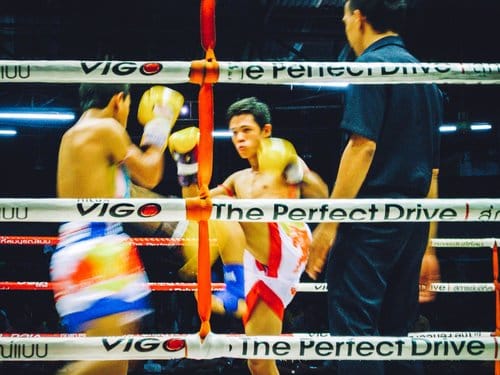Muay Thai — a Sport for Kids?
Two kids fought the first match. Their eyes were locked hard on to each other, intense, brutal even. I wondered if it was right to be watching this at all.

If you pay the standard higher charge for foreigners, the concierge tells the folks at Lumpinee to expect you. You are received well on arrival, seated on a stool in a waiting area until the previous show has ended, and then taken inside — free from the bother of waiting in a line. You're given a place by the ropes.
The ring was bright, but where we sat, the spills from the last show hadn't been mopped off the floors. The regulars sat behind tall, meshed barricades. An American sat next to me, and next to him another American, young, of Indian origin. They sensed their common nationality and promptly plunged into conversation. They talked every moment, for more than two hours, until the very end, even during the tensions in the matches, not pausing when a sensational knockout happened in the sixth game, not also in the top-billed seventh match. They spoke American things, long and loud.
Two kids fought the first match. Their eyes were locked hard on to each other, intense, brutal even. I wondered if it was right to be watching this at all. The announcer did say something about a minimum age, but she spoke with a strong accent, and I couldn't pick up her meanings. But these were kids alright, and the loser's mean face broke and turned teary when the match went off his control. But his backers showed him tenderness when he came off the ring, his head limp and hanging forward in shame and disappointment.
As the show progressed, older boys entered the ring, and the matches began to get better. The fight starts with a slow, graceful dance to pipe — the pipes are played during the bouts as well. When the fighters need to gather themselves, they step in tune and pause and advance to the rhythm of the music. The referees are sharp and won't allow too much risk— so the players are quite safe. Still, the the boys take wrenching blows.
In the prime match, the losing boxer moved snake-like, his head dancing sideways on his neck, and his technique was to curve his hand each time in a slow, searching motion, seeking a path to his opponent's jaw. The winner's approach was brusque and seemed rough, and he did not put his technique too much on show. In quick time he had his opponent all wound up, the loser's punches getting wilder, the face agitated, control leaving him.
I followed the winner out. They shot pictures of him at a victory-spot, and I had someone take my picture with him. I went with him into the dressing hall as well, a dark open space, and there people got busy with his hurts. Meanwhile, the loser had come into the room. He was sitting at the tables far back, all by himself. He wasn't getting attention, I was surprised to see, but it seemed like he didn't want anything to do with anybody anyway.